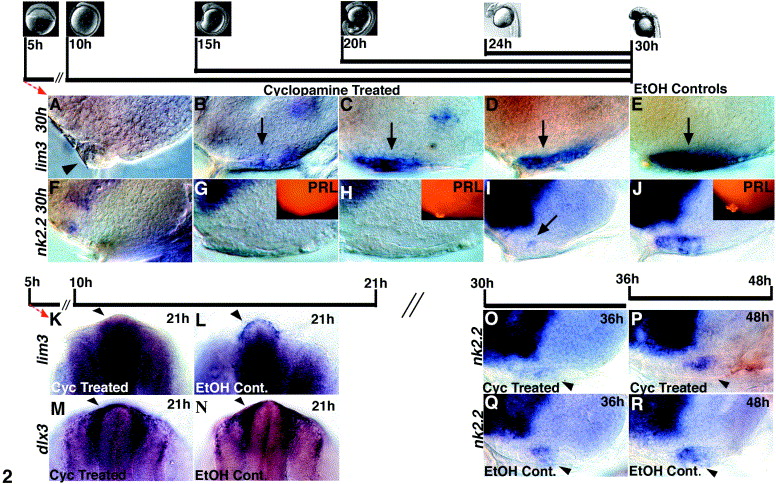Fig. 2 Timed inhibition of Hh signaling with cyclopamine. Initiation and duration of cyclopamine treatment is indicated by black bars with images showing appropriately staged embryos (images from Karlstrom and Kane, 1996). Embryos in (A–J) were fixed and labeled at 30 h. (A) Treatments starting at 5 or 10 h result in the loss of a visible adenohypophyseal placode and loss of all lim3 expression at 30 h. These embryos often develop an ectopic lens in place of an adenohypophysis (arrowhead in A). (B) Treatment at 15 h severely reduces lim3 expression in a thin but visible placode. (C, D) Embryos treated starting at 20 or 24 h have smaller adenohypophyses with reduced lim3 expression. (E) Control embryos treated with an equal volume of EtOH (cyclopamine carrier) have normal adenohypophyses that express lim3. (F, G) Cyclopamine treatments starting at 5, 10, or 15 h eliminate nk2.2 expression and PRL cells (inset in G) at 30 h. (H) Treatment at 20 h eliminates nk2.2 expression and severely reduces PRL cell numbers (inset). (I) Cyclopamine treatment starting at 24 h reduces nk2.2 expression in the anterior adenohypophysis (arrow). (J) Normal nk2.2 and PRL labeling in EtOH-treated control embryos. (K) Cyclopamine treatments at 5 or 10 h eliminate lim3 expression at 21 h. (M) dlx3 expression at 21 h is not affected by early cyclopamine treatments. (L, N) lim3 and dlx3 expression in EtOH-treated controls. (O, Q) Cyclopamine treatment starting at 30 h reduces nk2.2 expression at 36 h relative to controls (arrowheads). (P, R) Embryos treated from 36–48 hours have nk2.2 expression similar to that seen in control treated embryos (compare arrowheads). (A–J) and (O–R) show lateral views, anterior to the left, eyes removed; (K–N) show dorsal/anterior views, anterior up. Cyo, cyclopamine.
Reprinted from Developmental Biology, 254(1), Sbrogna, J.L., Barresi, M.J., and Karlstrom, R.O., Multiple roles for Hedgehog signaling in zebrafish pituitary development, 19-35, Copyright (2003) with permission from Elsevier. Full text @ Dev. Biol.

